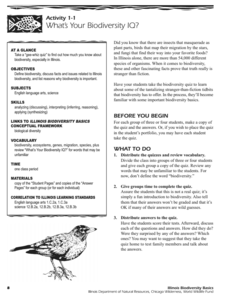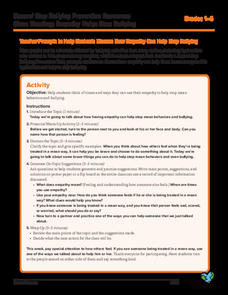Consortium for Ocean Science Exploration and Engagement (COSEE)
Understanding the Food Web
Building on prior knowledge of the pervious instructional activity in the series, pupils explain the previous instructional activity to each other. Then they write a simple guide for a young child to read on the same topic.
National Museum of the American Indian
To Honor & Comfort Native Quilting Traditions
"Native American history leaps boldly off the colorful quilts and patchwork designs." Learners discuss Native American identity and symbolism by reading about a variety of Native quilters and their unique art process, and participate in...
PBS
Stories of Painkiller Addiction: Prescription Drug Abuse Awareness Campaign
The I-STOP law was designed to regulate the distribution and tracking of prescription drugs. After reading an article about its signing and implementation, middle and high schoolers work together to come up with their own ideas for an...
Illinois Department of Natural Resources
Section One: What is Biodiversity?
Four intriguing and scientific activities invite learners to explore the natural resources of their town. The activities cover concepts such as genetic traits, organizing species in a taxonomy, the differences between different species...
Smithsonian Institution
Solomon G. Brown: Letter Writing
Personal correspondence in the form of letters is not as common as it once was. This resource presents an opportunity for you to introduce your class to letter writing and cover topics in social studies. Learners read a letter written in...
Overcoming Obstacles
Blowin' in the Wind
Working together isn't as easy as it looks! Small groups of classmates try to keep a balloon in the air using only a straw, their breath, and team communication.
Core Knowledge Foundation
A “Whole” Lot of Fraction Fun!
Young mathematicians are introduced to fractions in a unit that helps them to understand parts of a whole.
PBS
Stories of Painkiller Addiction: Contemplating Nature vs. Nurture
Does having an addict in your family make it more likely to become one yourself? Explore the genetic risk factors, as well as the prominent environmental influences, for substance addiction in a lesson that encourages awareness and open...
National Association for the Education of Young Children
Ten Tips for Involving Families through Internet-Based Communication
Communication is key for a successful parent-teacher relationship, but communication can be difficult when there are thirty-plus families involved. Make your life easier with online communication and an article that details 10...
Canadian Civil Liberties Education Trust
That’s Not Fair!
As part of a series of critical thinking exercises, kids consider issues of social justice, especially the factors that must be considered when trying to balance conflicting rights and freedoms.
Stanford University
Lesson Plan: Montgomery Bus Boycott
Most of us have heard of Rosa Parks, the Montgomery Bus Boycott, and Martin Luther King, Jr. But what about Claudette Colvin, Virginia Durr, Freedom Summer, or the Birmingham Children's Crusade? A five-instructional activity...
Committee for Children
Class Meeting: Empathy Helps Stop Bullying
A lesson instills the importance of how empathy has the ability to aid in stopping bullying behavior. Scholars discuss, in-depth, a series of three questions. Using class input, an anchor chart is made then displayed for reference.
California Academy of Science
Fresh Solutions: Design Thinking Challenge
How do people transport fresh water long distances to ensure everyone has access to it? The final activity in the 10-part Fresh Solutions unit encourages individuals to design their own solution, or solutions, to that very problem....
Curated OER
Helping Ourselves: Why Philanthropy Works
Students discover the concept of philanthropy. In this civics activity, students investigate the role of philanthropy in our society, and how it makes life better for all.
Curated OER
Critical Analysis: "Behind the Formaldehyde Curtain" by Jessica Mitford
In this "Behind the Formaldehyde Curtain" worksheet, students analyze the purpose and the meaning as well as summaryize the text. Students determine three elements that the author used to make her point.
Curated OER
From Printed Page to Home Page
Students compare on-line newspapers to their print counterparts
Curated OER
Reading Pattern Books
Students investigate pattern books. In this literature lesson, students read the book Brown Bear, Brown Bear What Do You See? and use echo and choral reading strategies. Students identify the pattern in the text and write about the...
Curated OER
Korean And Vietnam Conflicts: Similarities And Differences
Eighth graders study the historical significance of the Korean and Vietnam Wars in this unit of study. They investigate the different ideologies that were involved and examine the effect of the wars on local veterans.
Curated OER
Critical Reading #1: "The Myth of Doomed Kids"
In this critical reading worksheet, students establish the context, author, and purpose of the piece then sum up the ideas that the author is trying to convey.
Curated OER
"Shooting an Elephant" Critical Reading
In this "Shooting an Elephant" critical reading worksheet, learners identify the author and general topic of the piece. Students sum up the message of the author and identify the type of writing.
Curated OER
Letters Home
Students read a short biography of Jacob Early, a member of the Ohio Volunteer Infantry in 1862. For this Civil War lesson, students rewrite a letter written by him, editing for spelling, grammar and punctuation. Students further discuss...
Curated OER
Reading Clues
Critically Evaluating Alarming News students use a guided reading strategy to explore news articles about the Washington-area sniper attacks, and conduct a roundtable discussion to investigate public reaction to the case. October 17, 200
Curated OER
Breathing Easier
Students explore asthma, and then write proposals outlining how teachers, coaches, administrators and school support staff can be better prepared to treat students with asthma.
Curated OER
A Read-In
Young scholars explore philosophy by participating in a philanthropic activity. In this book read-in lesson plan, students collect a group of used books and illustrate an image to go along with the story. Young scholars donate these...























